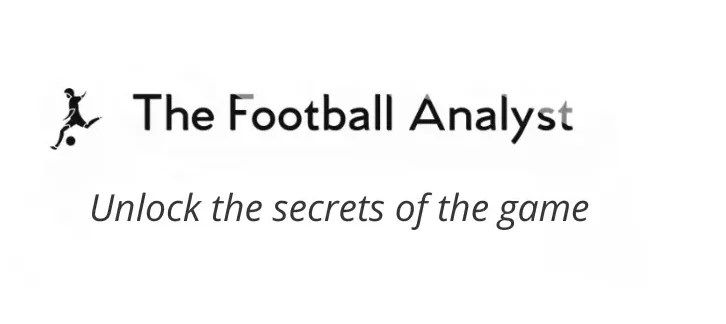Thiago Motta’s Juventus has brought a fresh and exciting tactical approach to one of Italy’s most storied football clubs. Known for his innovative ideas as a player, Motta has seamlessly translated his vision into coaching, shaping Juventus into a dynamic and versatile side. In this tactical analysis, we will break down the key principles of Motta’s Juventus, focusing on their formations, pressing patterns, and fluid style of play. From defensive organization to clever attacking transitions, let’s dive into how Thiago Motta is reshaping Juventus on the pitch.
Build-up
Low Build-up
In the low build-up, Thiago Motta sets his team up in a 1-4-3-3 formation with a back four, one number-six, two number-eights, and a front three.
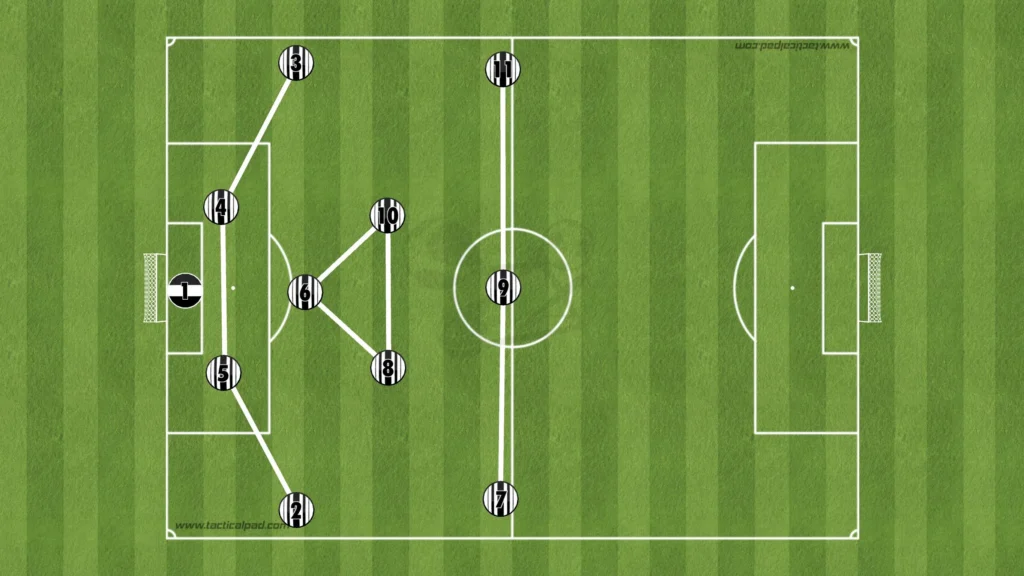
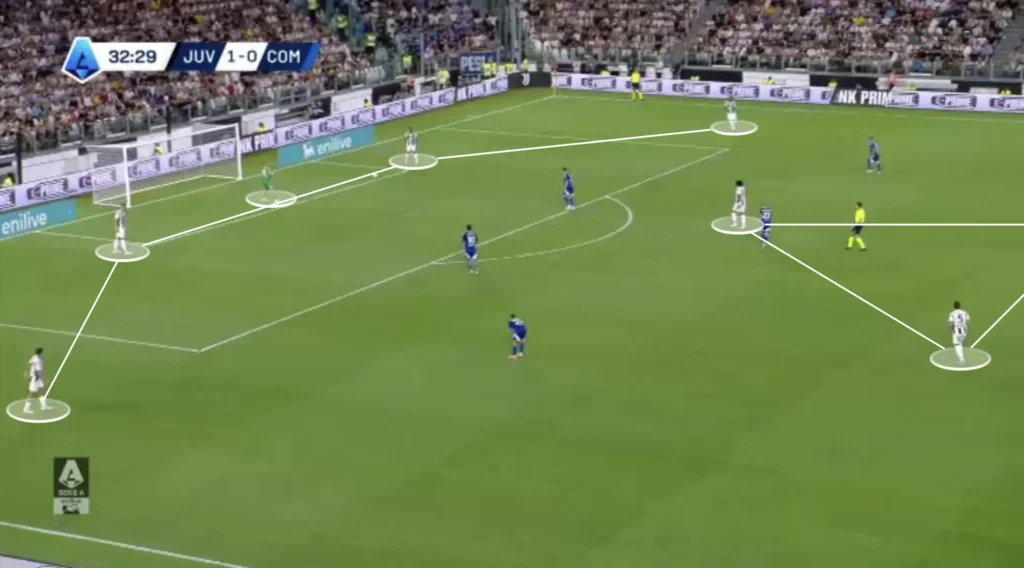
They often drop with the number eights and like using the goalkeeper, which creates numerical superiorities, allowing them to beat the press.
High Build-up
In the high build-up, Motta wants to build with five players. The five building players will either be in a 2+3 structure:
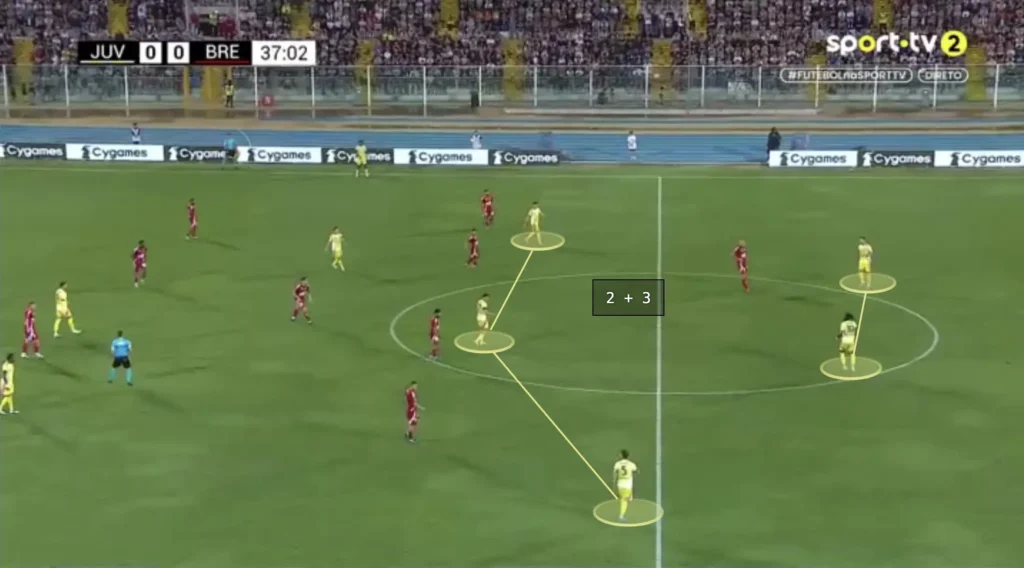
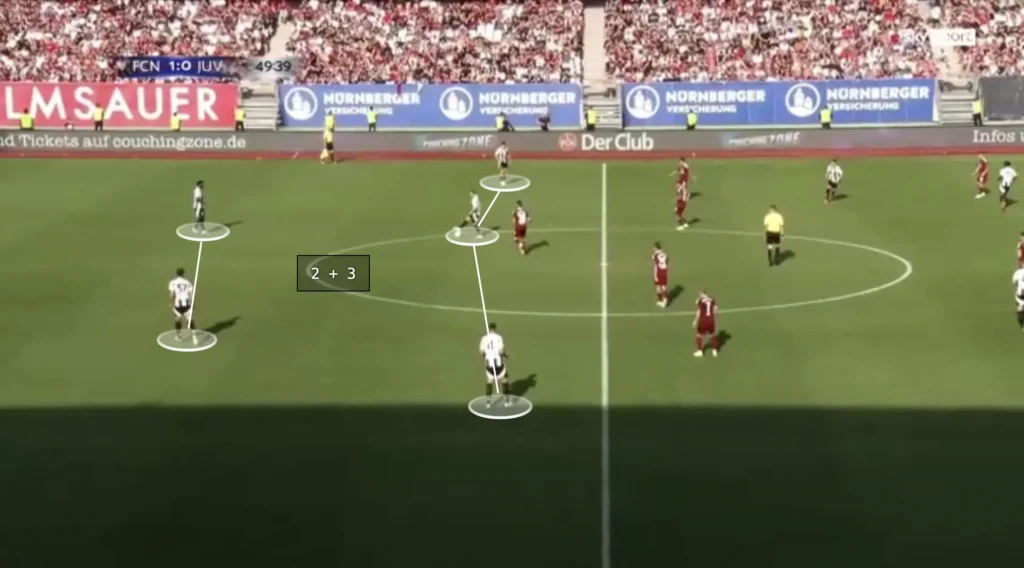
Or in a 3+2 structure:
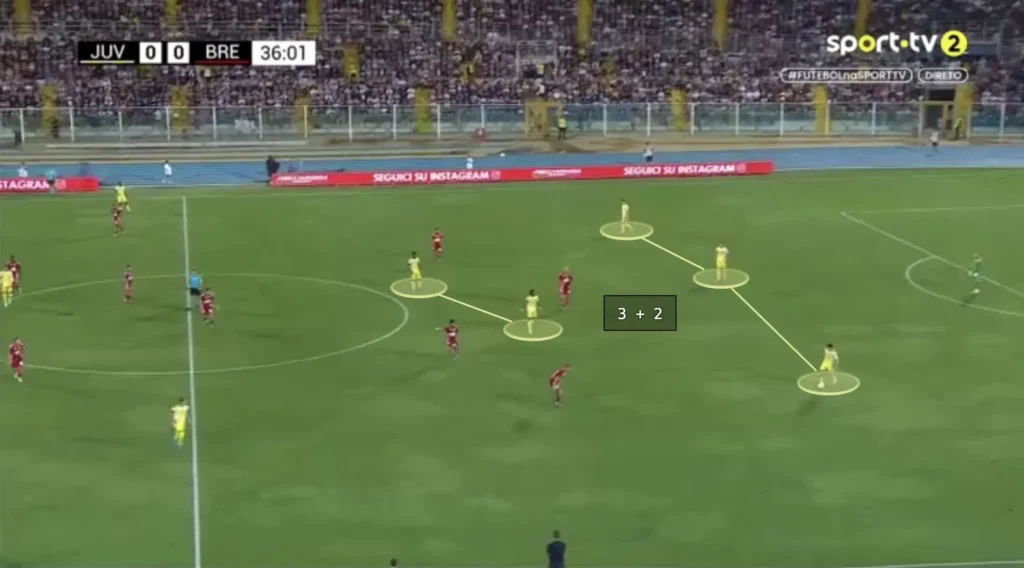
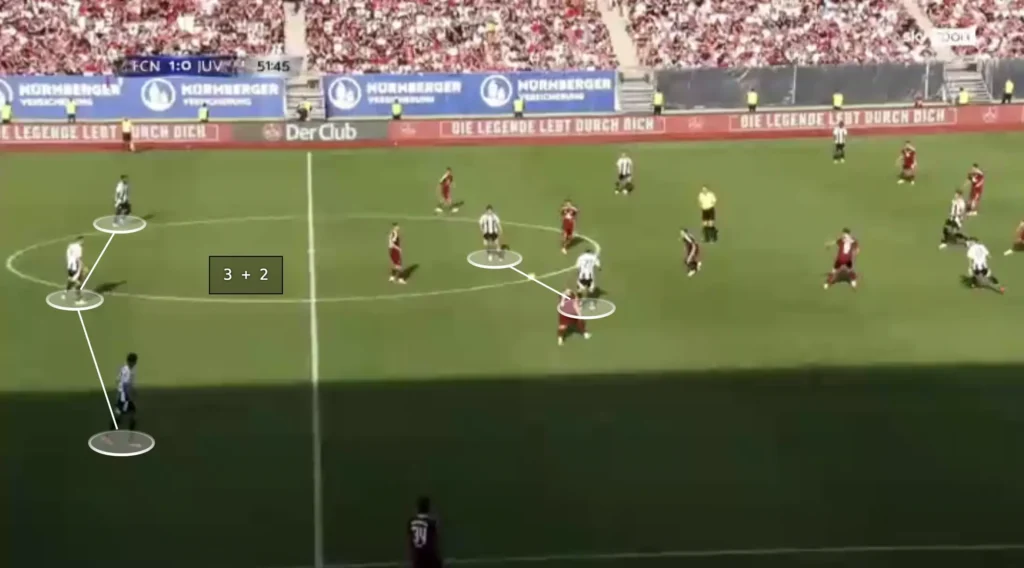
Motta emphasizes fluidity for these players, who have the freedom to move between the structures during the build-up phase. However, which structure they use mostly depends on how many players the opposition has in their forward line. Motta usually wants his team to be +1 in the backline against the opposition’s forward line. If they are +1, one center-back will be free. The ball can be played to the free center-back, who can take the ball forward, beating the opposition’s first line. However, Motta does not want to be +2 in the backline against the opposition’s forward line. He wants a numerical advantage, but with two players more than the opposition, they could have more players higher up the pitch.
Therefore, Juventus build in the 2+3 structure when playing against one forward. This gives them an extra midfielder without losing the numerical advantage at the back. With a 2v1 with the backline against the opposition’s forward line, one center-back will still be free, which allows them to beat the opposition’s forward line and progress the ball up the pitch.
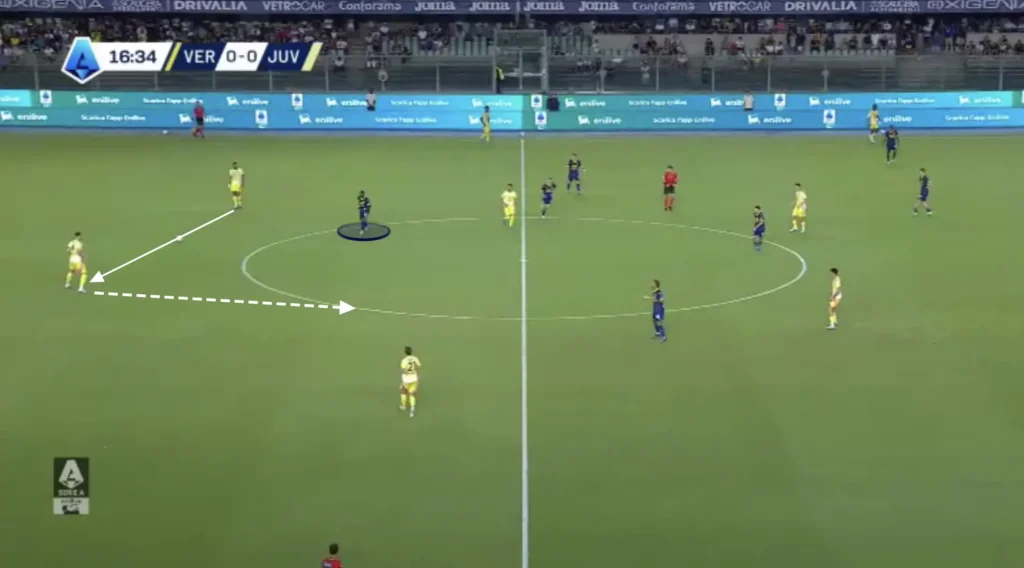
Against two forwards, they will use the 3+2 structure, looking to find the free center-back and advancing the ball forward.
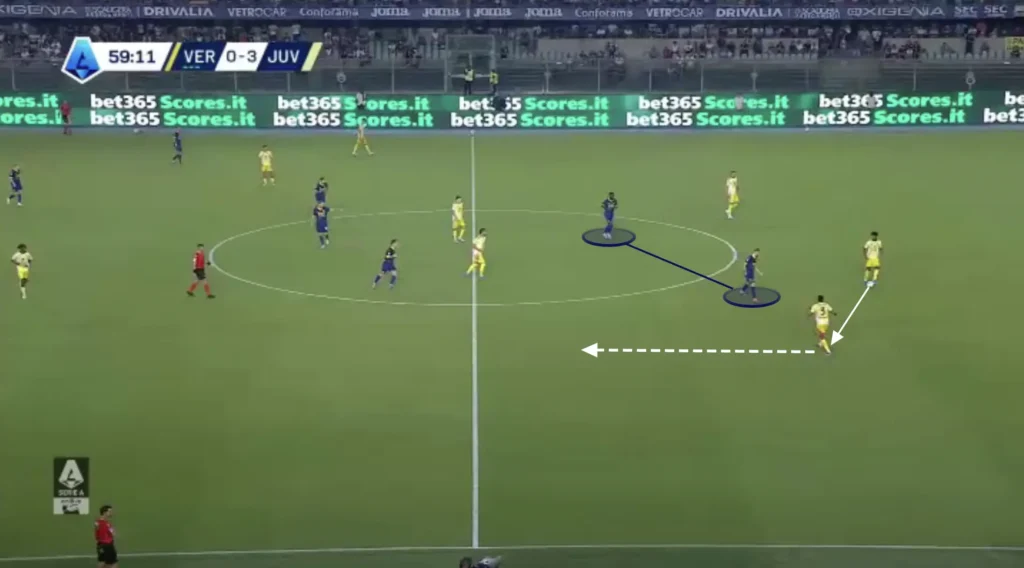
The five players who do not participate in the initial building phase will create a front five.
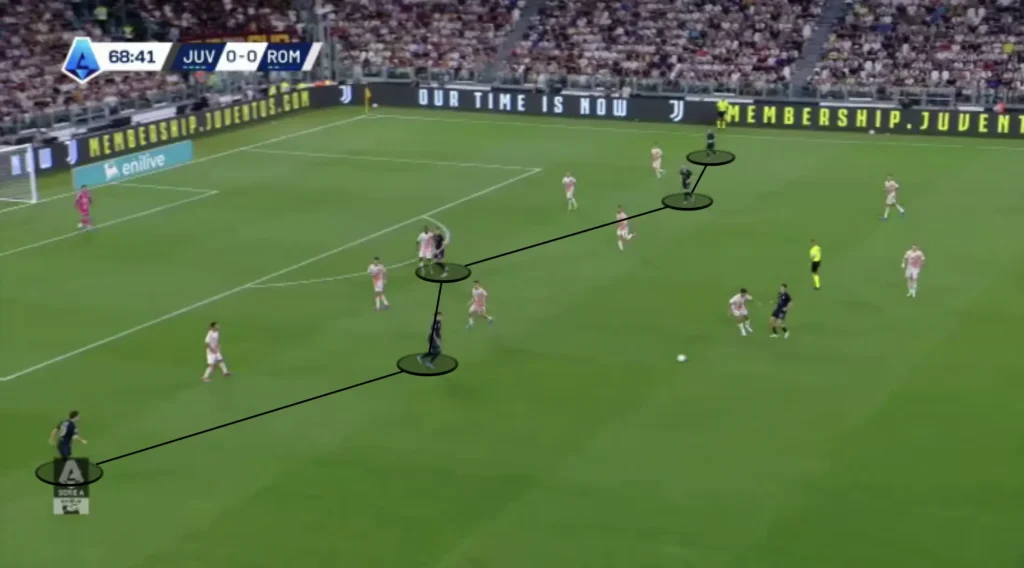
This means Juventus will be in a 1-2-3-5 formation or a 1-3-2-5 formation during the high build-up. These formations allow for a strong presence in the midfield, which helps in controlling the game and dictating the tempo.
Numerical Advantage in the midfield
Juventus will usually have only one player on each wing and the rest in the center during the high build-up, regardless of the formation. Having only two players out wide and the rest in the middle creates more options in the center and less space between the players. Motta likes this because he prioritizes playing through the middle. He needs one player out wide to pull the opposition apart while the rest create numerical advantages in the midfield areas. When a team outnumbers the opposition in the midfield, it can more easily retain the ball, exploit spaces, and progress the ball through the center. This advantage forces the opposing team to chase the game, which can lead to defensive errors and create opportunities for breaking down their defense.
Another purpose for keeping many players in the middle is to shorten the distance between them. This shortens the length of the passes, which naturally shortens the time between passes. This means the opposition players will have less time to push up and press, giving the Juventus players more time and control.
Fluidity
Juventus’ fluidity in the build-up under Thiago Motta has been a key aspect of their tactical evolution. The team often adopts a dynamic approach, shifting between formations to create numerical advantages and exploit spaces. Motta emphasizes versatility, with players interchanging positions seamlessly to maintain possession and disrupt the opposition’s defensive structure. The most fluid players in Juventus’ system are the center-backs and holding midfielders, who rotate and change positions to confuse the opponents. A holding midfielder will often drop, dragging away an opposition midfielder, which opens the space in the middle. A center-back will run into the open space and receive the ball, allowing him to turn and progress the ball up the pitch.
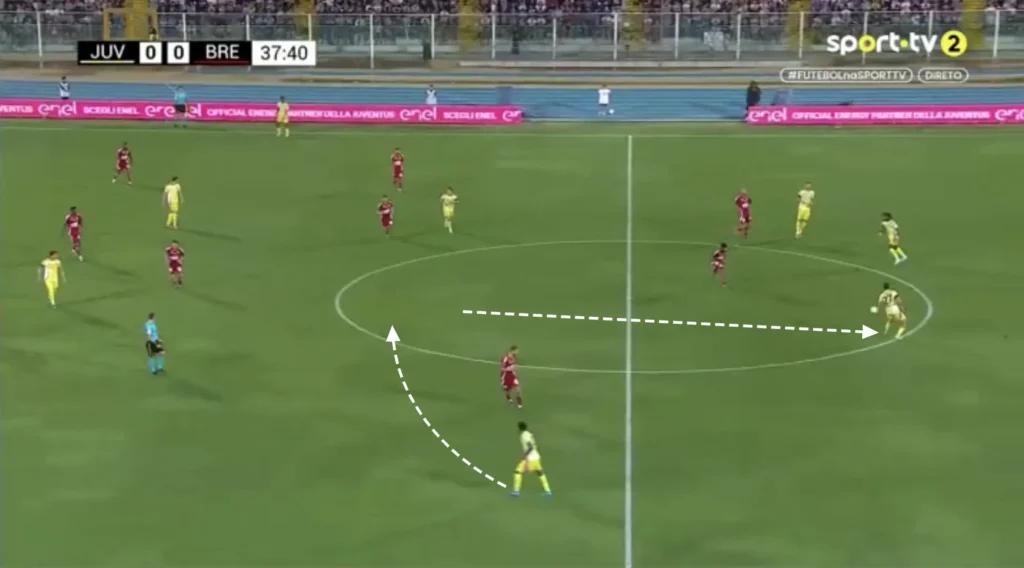
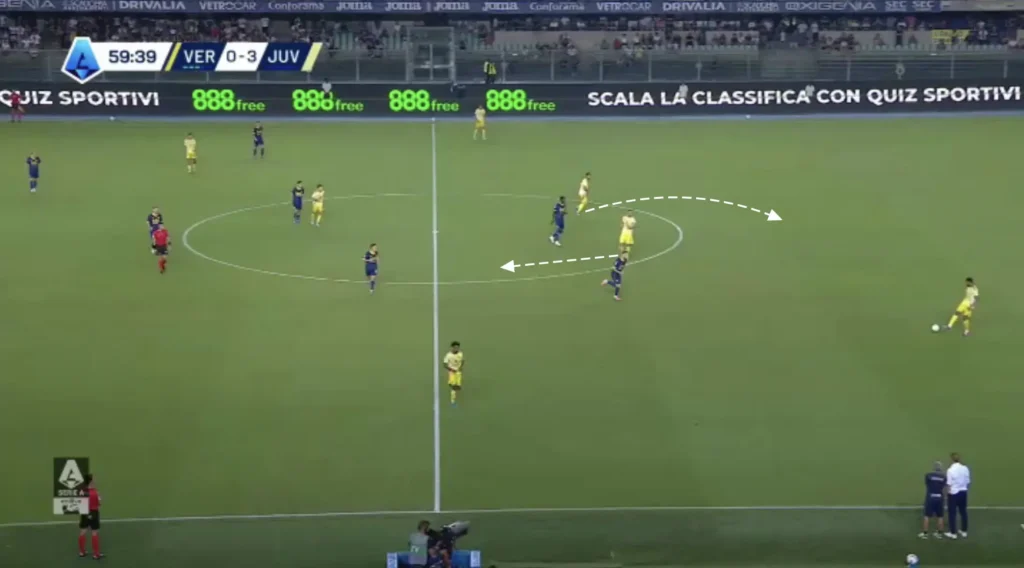
While it demands a lot of technical and tactical skills from the players, this fluidity has created new dynamics for Juve’s attacking style, offering new solutions and ways of beating the opposition’s press. It enhances their ability to control the game while opening up opportunities for incisive passes and creative plays, making them a formidable force in the build-up phase.
Finding the Pockets
Thiago Motta’s players always try to find the attacking midfielders in the pockets. These “pockets” refer to the spaces between the opposition’s defensive and midfield lines, where the attacking midfielders can receive the ball in more advanced positions.
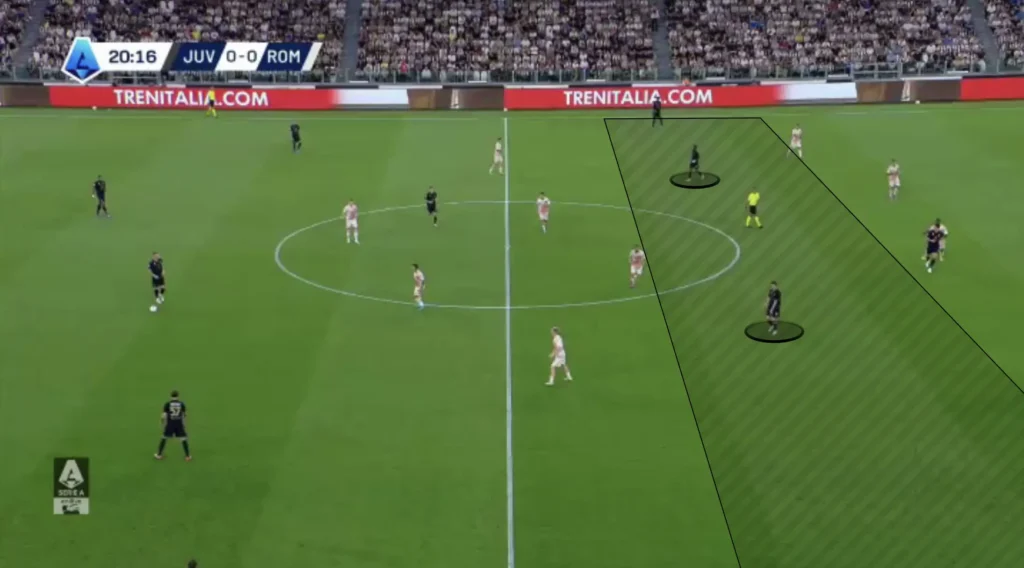
By positioning themselves intelligently in these pockets, the attacking midfielders can turn quickly and face the opposition’s goal, creating opportunities for through balls, driving runs, or direct shots. This positioning forces the opposition to make difficult decisions. If an opposition defender steps up and closes down the attacking midfielder, he potentially leaves space behind. If he stays back, he allows the midfielder time on the ball. The Juventus defenders and midfielders will look for straight passes, breaking the opposition lines and finding the attacking midfielders who can turn and drive at the defense.
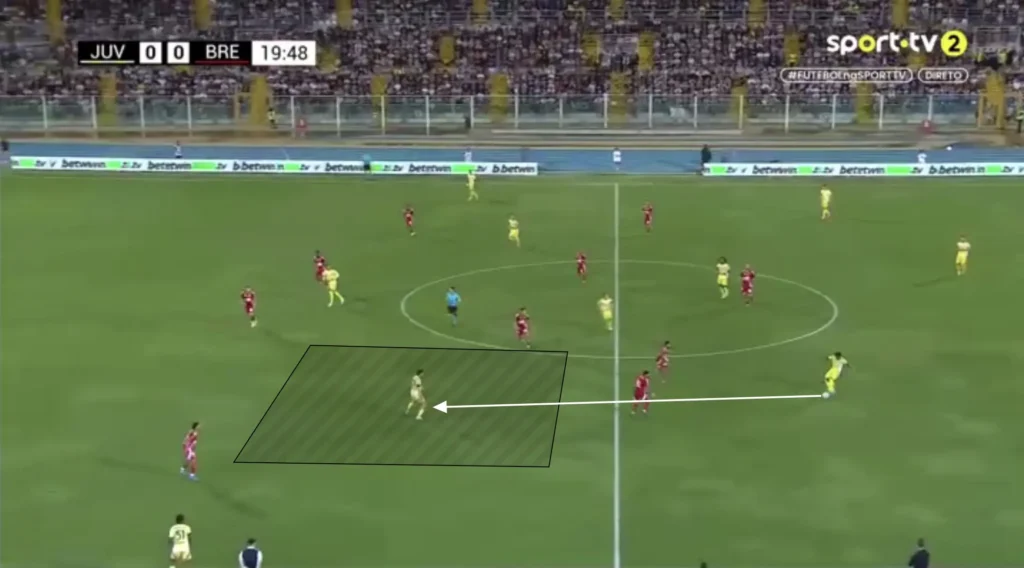
Finding these pockets is crucial for maintaining fluidity in attack and ensuring that the team can progress the ball effectively through the middle of the pitch.
Dropping Outside
When the opposition defends very compactly and does not allow the attacking midfielders to get the ball in the pockets, Juve’s attacking midfielders can drop outside to receive the ball there instead. They will wait for the opposition’s wide midfielders to press the wide center-backs and drop out into the space he left open. The opposition center-backs and central midfielders rarely follow these runs, not wanting to open the space in the center. Additionally, the winger, who is positioned high and wide, will be pinning the opposition fullback, not allowing him to jump on the dropping attacking midfielder. This means that the attacking midfielder can receive the ball, turn, and progress the ball unopposed.
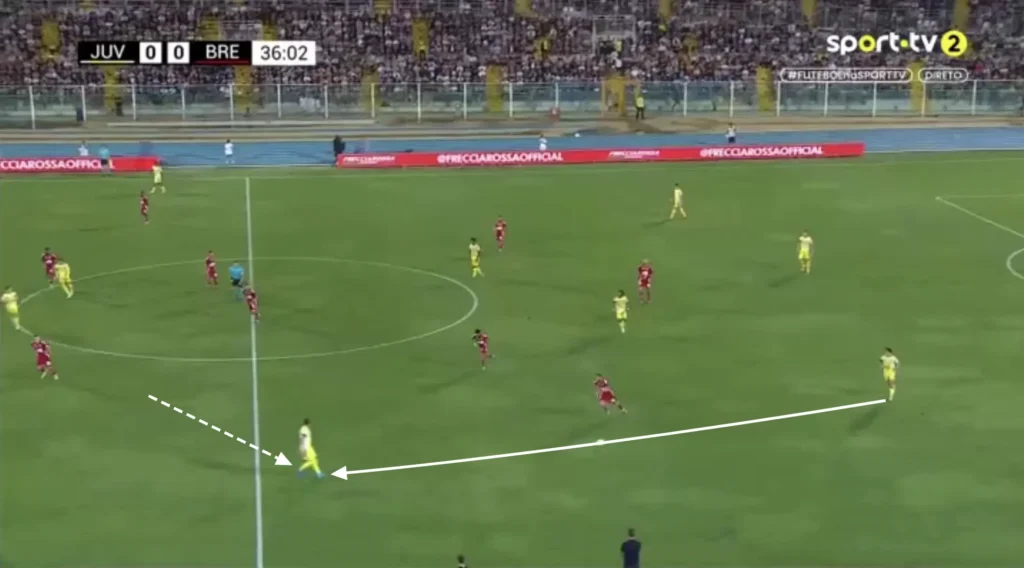
Numerical Advantages Against the Opposition’s Defense
Another aspect of Juventus’ high build-up is their ability to create numerical advantages against the opposition’s defensive line. Playing with a front five means the forward line naturally becomes numerically superior against a back four, which they are great at taking advantage of.
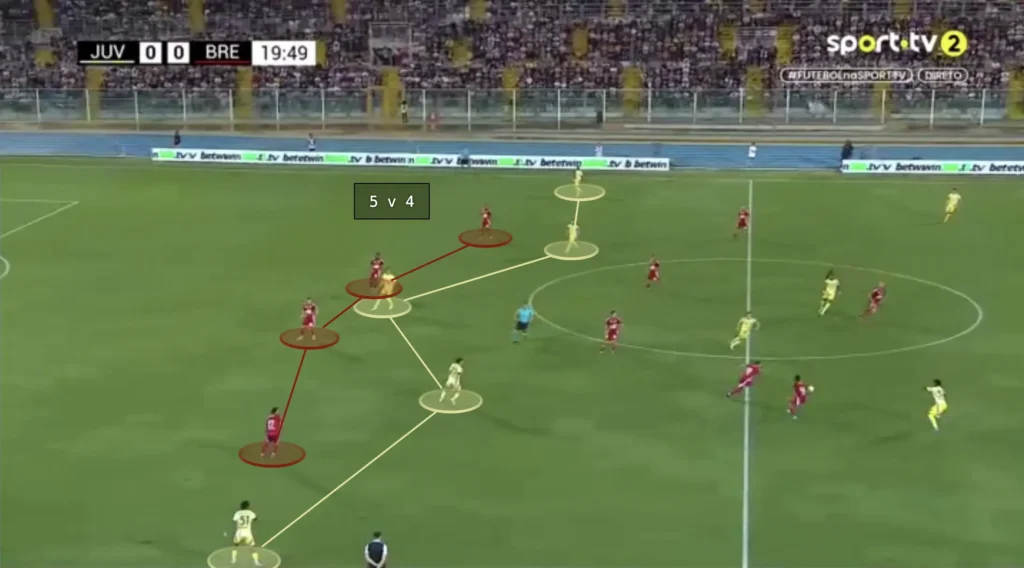
Motta’s players mainly exploit this by creating 2v1 situations against the opposition fullback. When the defending team is positioned on one side, the weak-side fullback becomes vulnerable to the long switch of play due to the 1v2 against Juve’s winger and attacking midfielder. The attacking midfielder will make a run in behind, the fullback will follow that run, and the space for the winger out wide will be opened. Motta’s team often capitalizes on this by getting the ball to the winger and creating many opportunities from 2v1 situations on the wing and in the half-spaces.
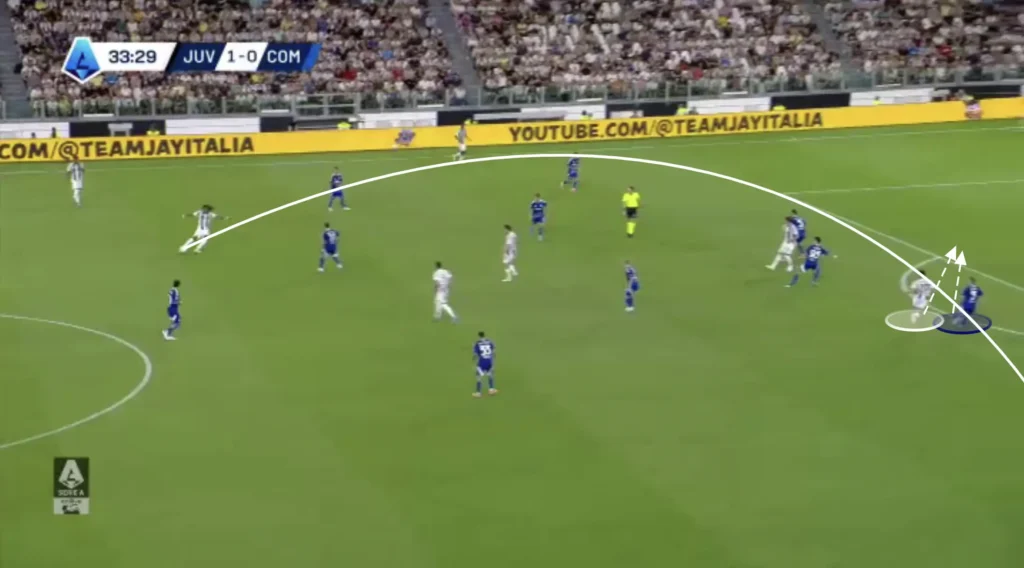
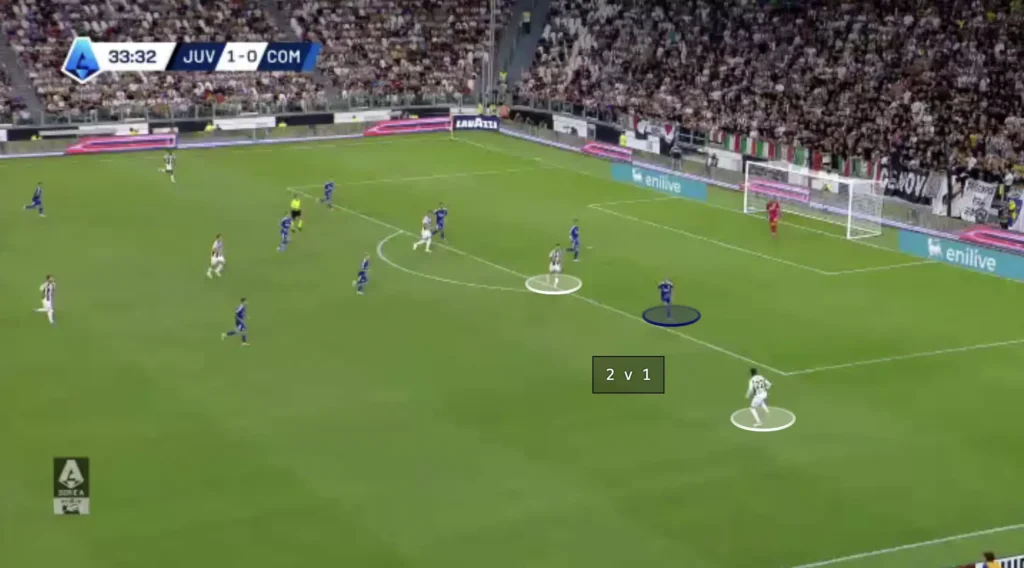
Counter-Movements
Juventus will also use counter-movements between the winger and attacking midfielder to exploit this numerical advantage. When a wide center-back has the ball, the attacking midfielder can make a run in behind while the winger drops to open the passing lane from the wide center-back.
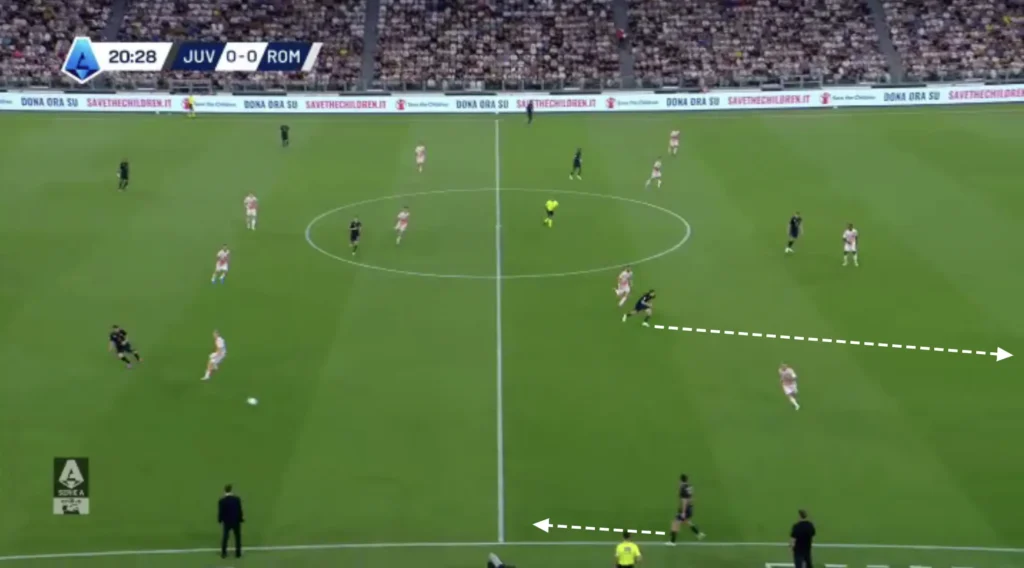
This creates a question for the opposition fullback. If he steps out on the winger, the space behind him opens up, allowing the center-back to play a through-ball to the attacking midfielder. However, if he stays inside to cover the run, the ball can be played to the winger, who can turn and attack the defense.
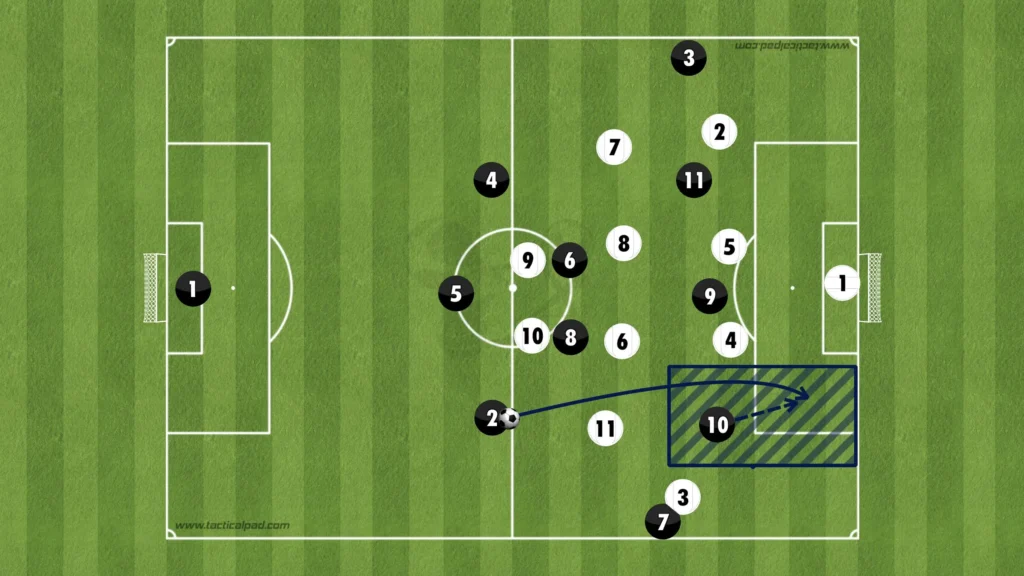
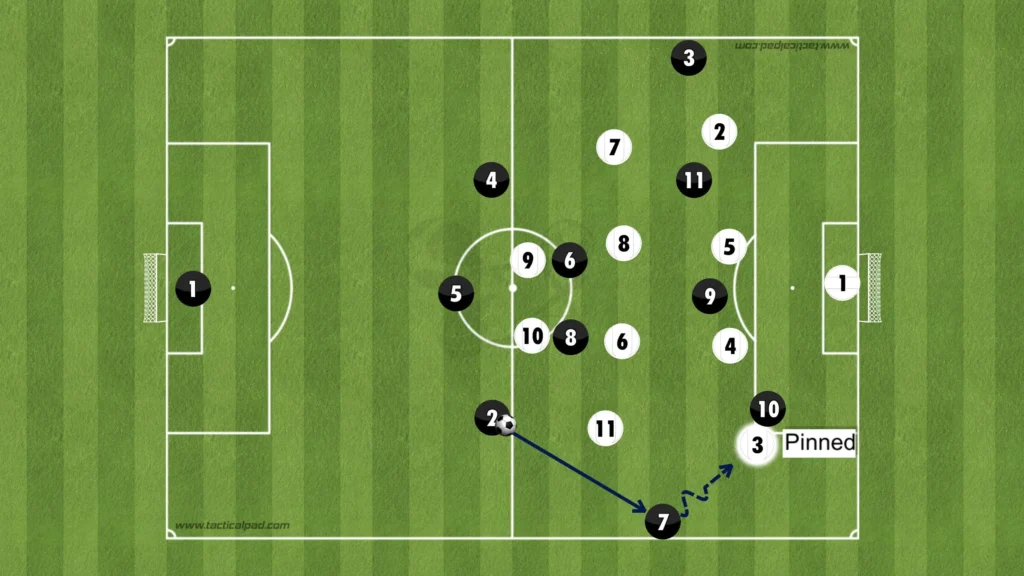
Final Third
Attacking the Half-Space
Motta’s players usually look to create chances by attacking the space between the opposition center-back and fullback. They primarily do this from the wide areas with underlaps from the attacking midfielders. When the winger receives the ball out wide he will attract the opposition fullback. This opens the space between the fullback and the center-back, which allows the Juventus attacking midfielder to make the underlapping run into this space. The ball can be played to the underlapping player, who can cross the ball into the box or attack his defender in a 1v1 situation.
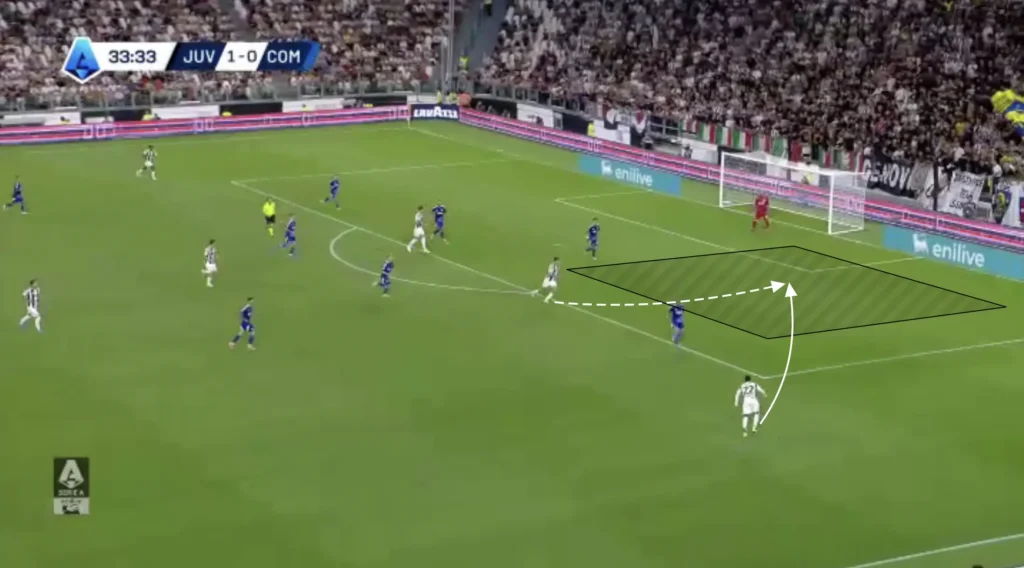
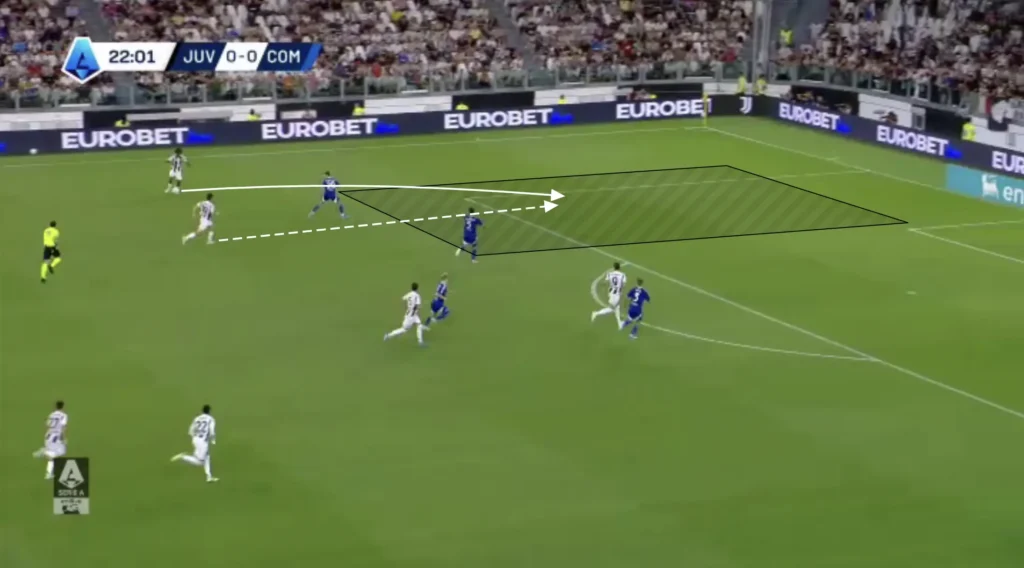
The winger does not have to play the ball to the underlapping player. The run from the attacking midfielder will often drag away an opposition defensive midfielder, which opens the space inside. The winger can take the ball inside and shoot or find a pass to a free player in front of the backline.
Many Players in the Box
The attacking midfielders and wingers look to make runs into the box when the ball is in the final third, often getting four or five players into these areas to create overloads. The numerical advantages in the box increase the chances of connecting with the cross, as more players present multiple targets for the crosser, making it harder for defenders to mark everyone effectively. Additionally, having multiple players in the box provides options for different types of finishes, whether it’s a header, volley, or a quick tap-in. It also allows for better positioning to react to second balls or rebounds, increasing the likelihood of capitalizing on any defensive errors.
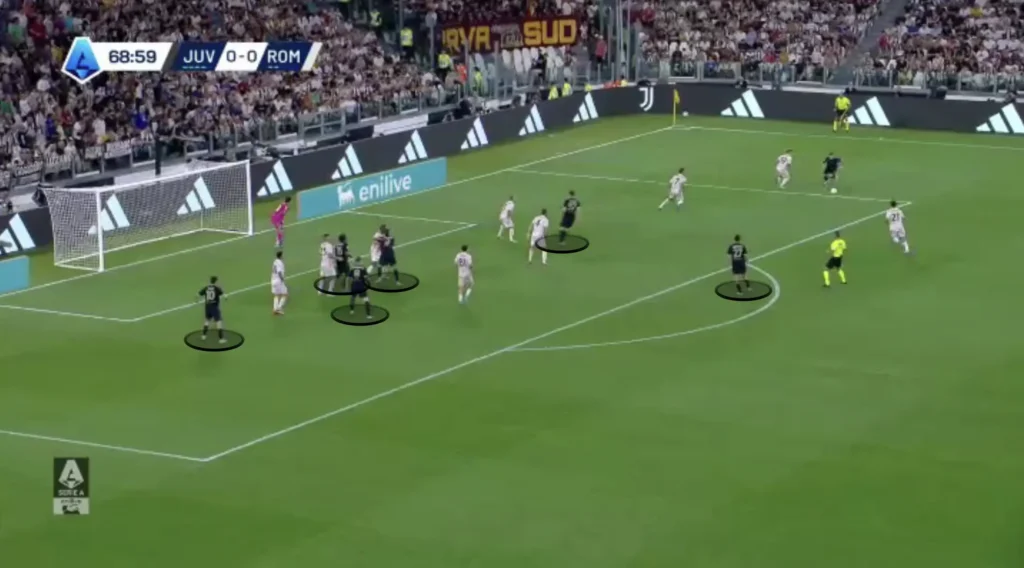
With five attackers, the wingers will score many goals from crosses at the back post. The opposition fullback will often be preoccupied with an attacking midfielder, which leaves massive space at the back post for the winger to attack. The winger can be found directly or indirectly if no one else connects with the cross.
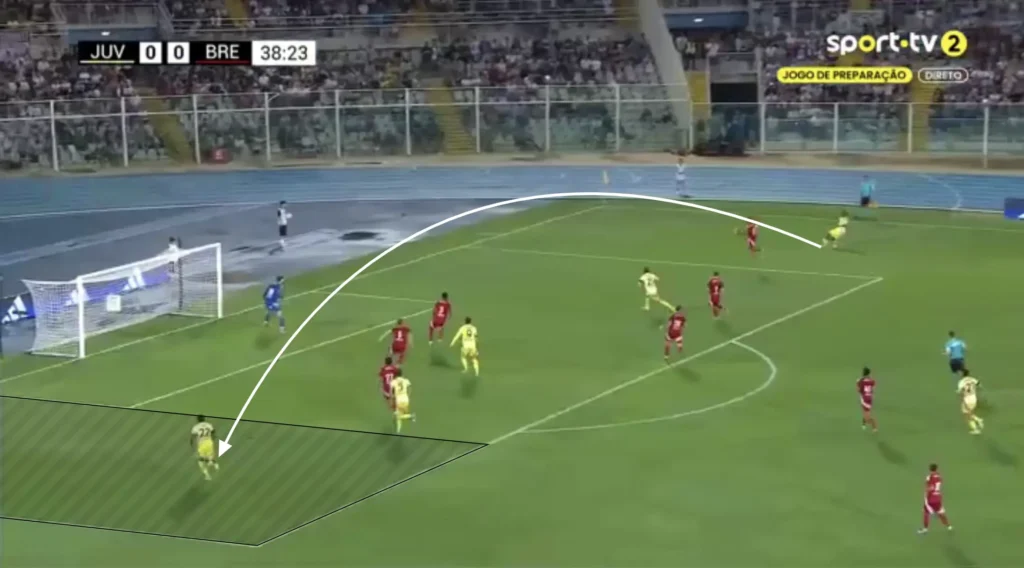
Defending
High Press
Thiago Motta places much value on being aggressive without the ball. This shows in Juve’s high pressure. Motta usually wants his team to go man-to-man and intensely press the opposition. Each player is assigned a direct opponent to mark tightly, ensuring no easy passing options are available. This intense pressure forces the opposing team into hurried decisions, often resulting in turnovers in dangerous areas. Juventus almost use their high press as an attacking threat, scoring many goals from winning the ball high up the pitch.
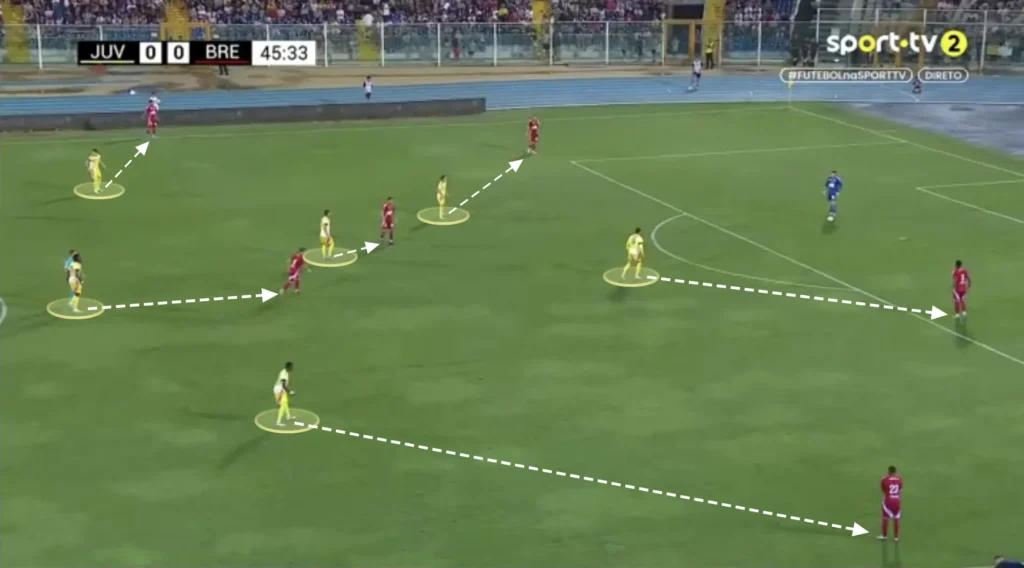
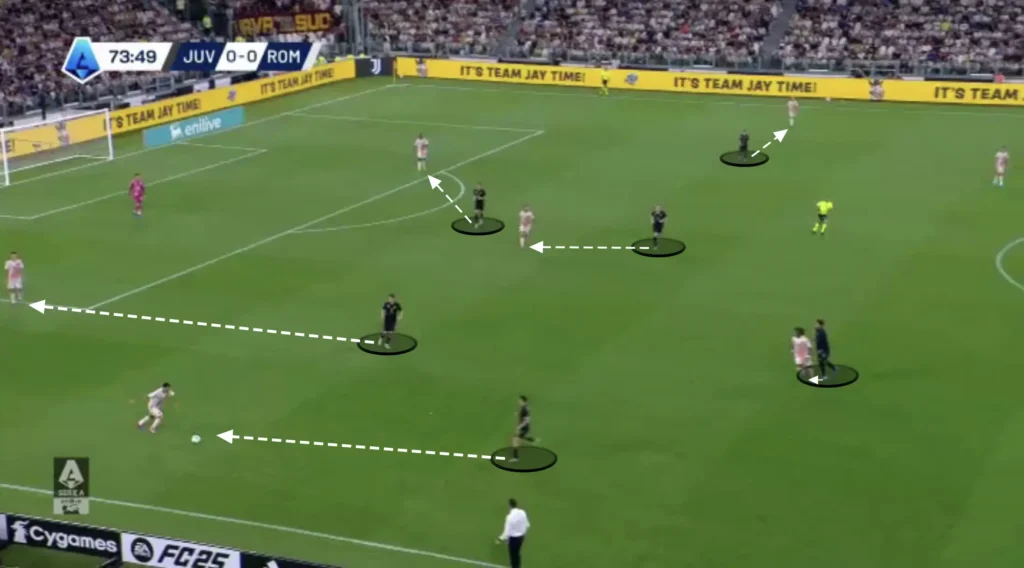
In a man-to-man system, it becomes crucial that the players know when to mark the opponent they are responsible for and when not to. If an opponent, for example, is very far from the ball, the Juventus player marking him does not need to be as close to him. He can instead come in and help create numerical superiorities in the center, decreasing the risk of dangerous 1v1 situations. Here, the ball is on the left side, allowing the Juventus players on the right side to stop marking their opponents as closely and come into the middle.
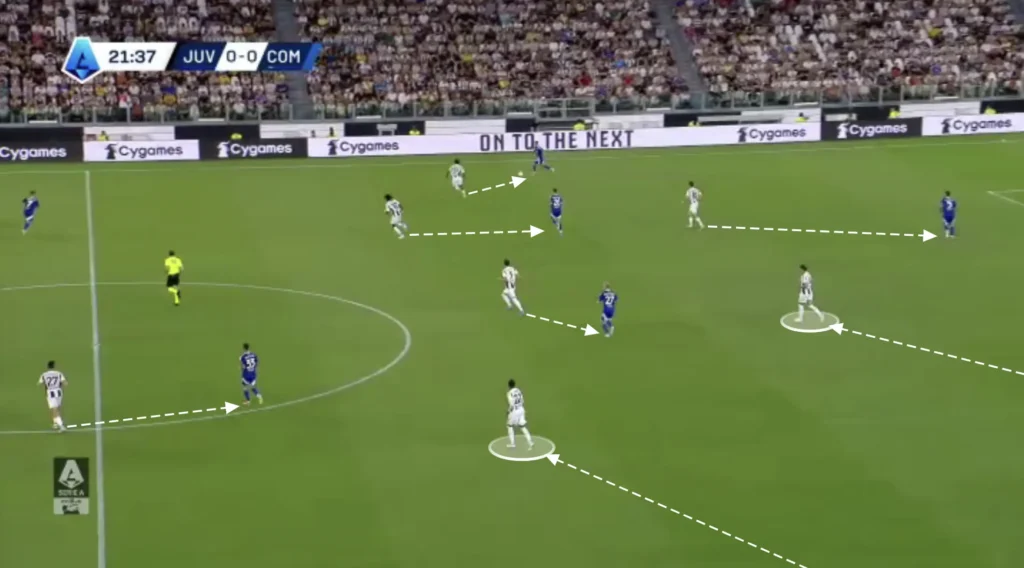
A rule of thumb for the players could be that the closer you are to the ball, the closer you need to be to your opponent. The further away you are from the ball, the further away you can be from your opponent.
Low Press
Motta’s Juventus uses a 1-4-2-3-1 formation in the low press. They look to set up in a mid-block, always trying to close the center and force the opposition out wide. The striker will usually be positioned slightly to the right and the number-ten to the left, aiming to stop any passes from the backline to the midfield. Motta wants his team to stay compact without dropping too low, preferably closing the space between the midfield and backline.
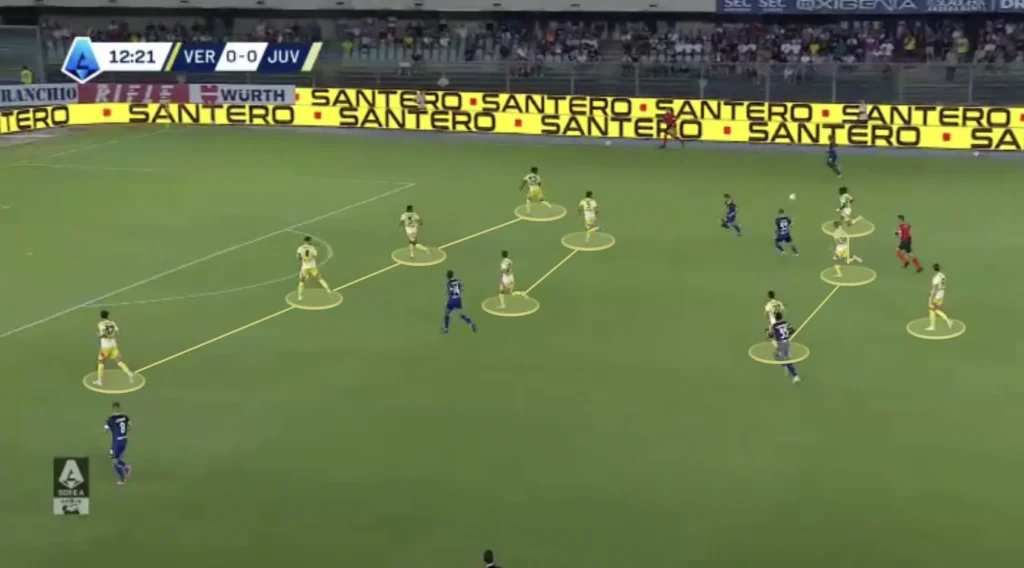
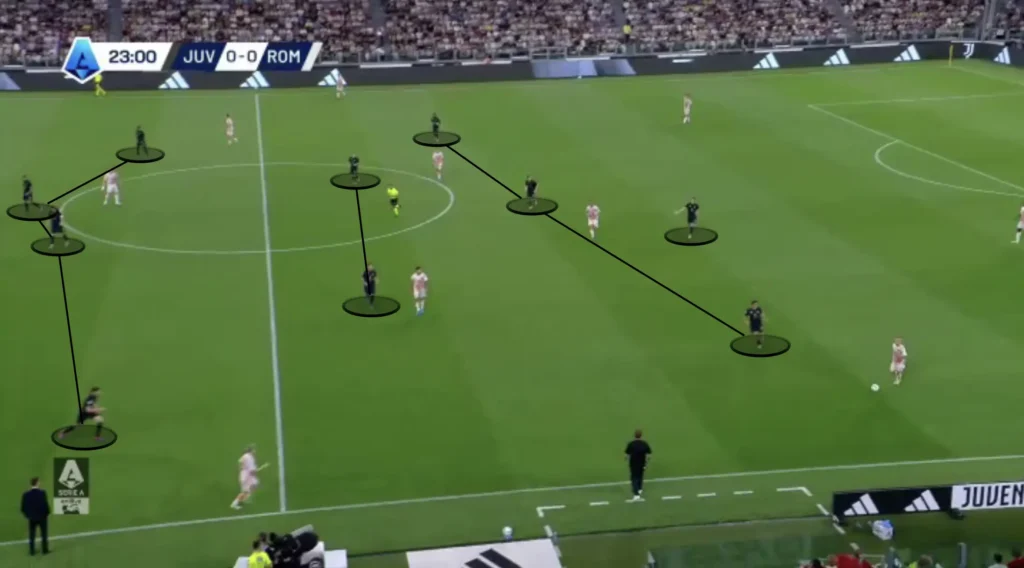
Defending in a 1-4-2-3-1 formation revolves around maintaining a compact and organized structure. The formation features a back four that provides stability, with two holding midfielders shielding the defense. These holding midfielders play a crucial role in breaking up opposition attacks and providing cover for the fullbacks when they advance. The three attacking midfielders work to stop entries for the opposition and cut off passing lanes, while the lone striker applies pressure on the ball. The team aims to stay compact, forcing the opposition to play wide and limiting their ability to penetrate through the center. By maintaining this structure, the 1-4-2-3-1 formation helps to control the middle of the pitch, making it difficult for opponents to create scoring opportunities.
Aggressive Backline
Juventus’ players, under Thiago Motta, are known for their aggressive approach in pushing up on opposition players. Rather than sitting deep, they step forward to close down opponents, cutting off passing lanes and applying pressure higher up the pitch. When the Juventus winger pushes up to pressure the opposition defenders, the fullback often follows to support the winger.
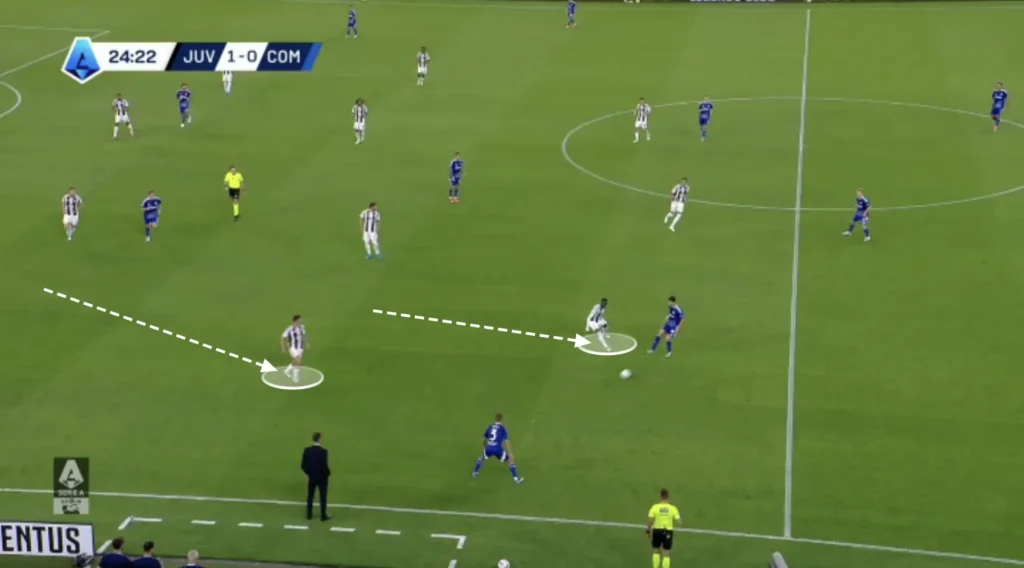
Because of this aggressive approach, big spaces in the backline will often appear. A center-back might push out on an attacking midfielder, leaving a big gap between the center-backs. A holding midfielder often drops down into the backline to fill these gaps and stop them from becoming an issue.
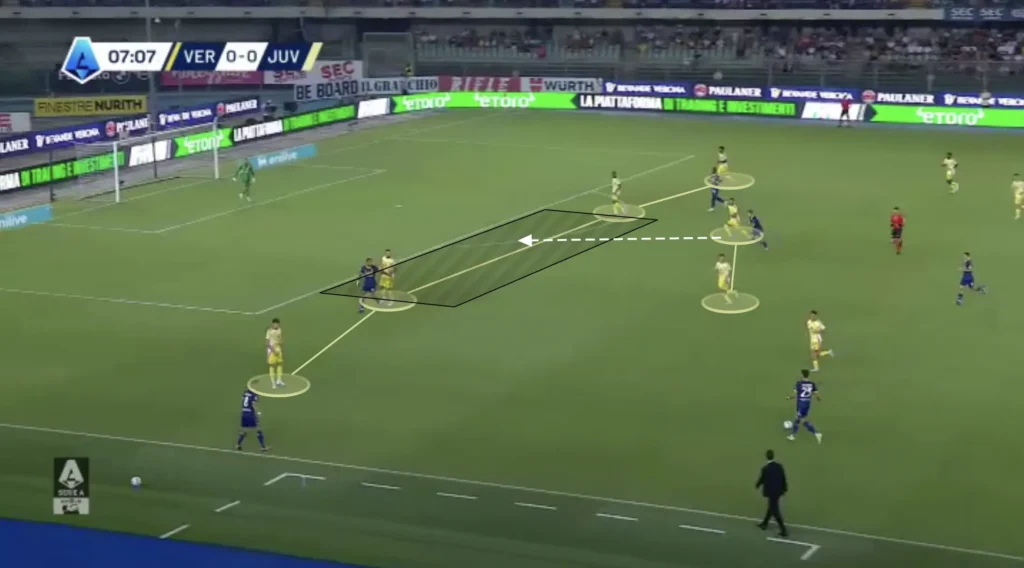
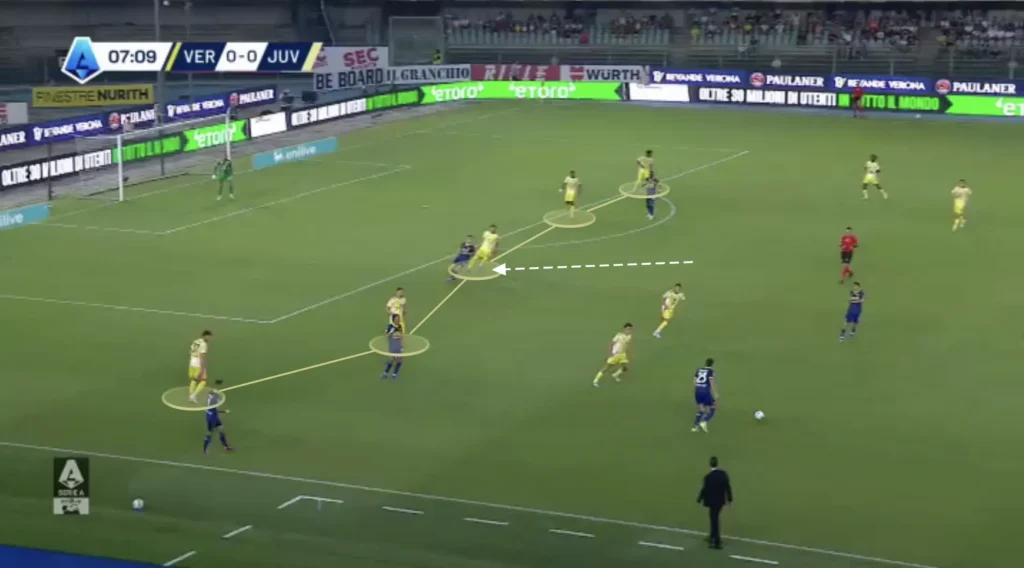
Squeezing the Pitch
Additionally, Thiago Motta always wants his team to squeeze the pitch when defending. This means constantly pushing the team up as much as possible. Every time the opponent plays a slow, sideways pass or a back pass, Juve’s first line of pressure pushes up, with the rest of the team following to stay compact. When the next pass comes, they push up even more, forcing the opponent back even more. They do this because it pushes the opponent further away from the Juventus goal, making it harder to create chances.
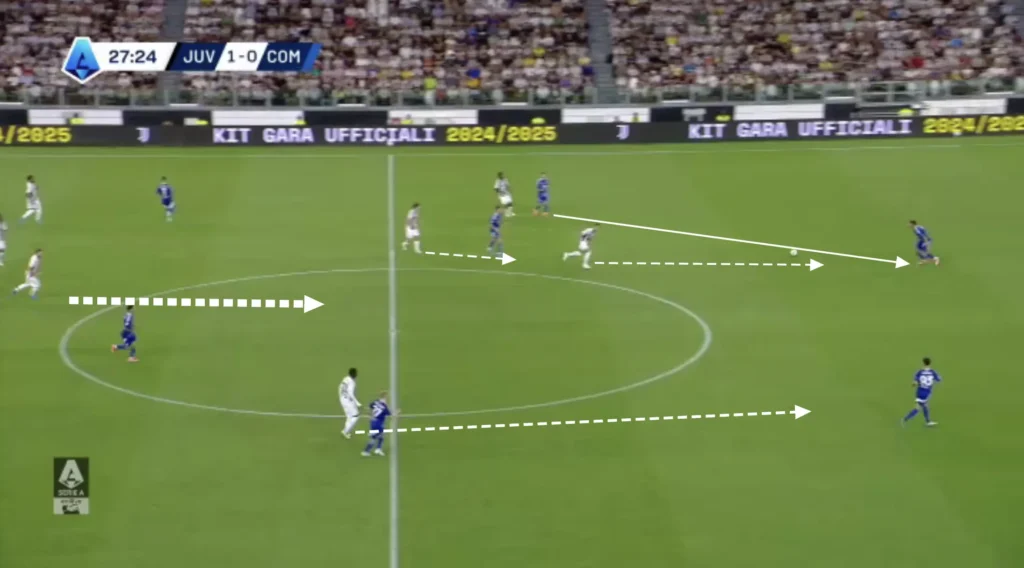
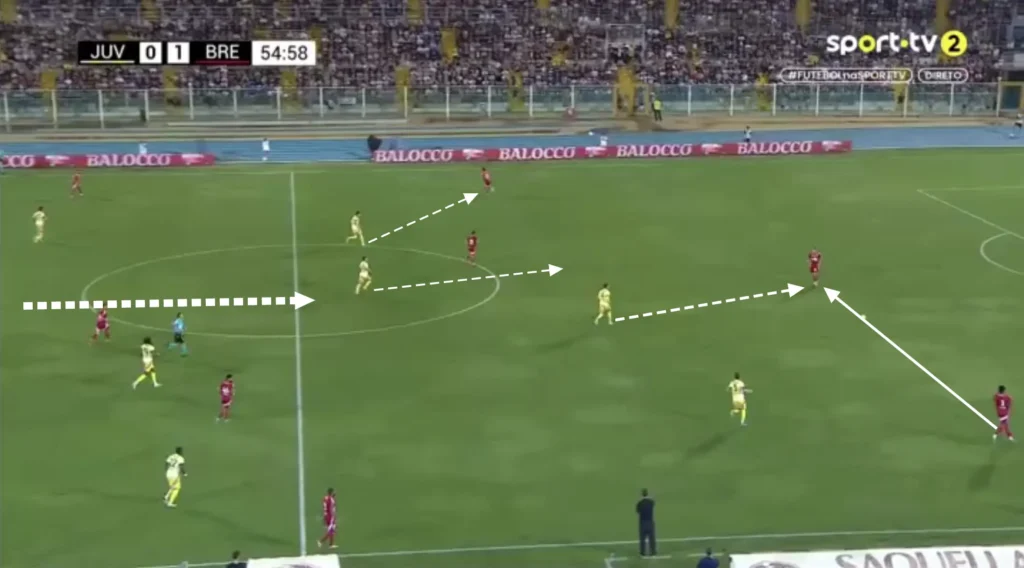
Transitions
Defensive Transitions
Positioning many players centrally, creating a numerical advantage in the midfield, creates good conditions in defensive transitions. Many players close to the ball after losing possession means that many players can work towards regaining possession. Motta’s players are also very aggressive in the first seconds after losing the ball. The four or five players closest will immediately jump on the opposition player with the ball and close the distance to cut off any passing lanes. This approach disrupts the opponent’s transition from defense to attack, forcing errors and creating opportunities to regain control in dangerous areas.
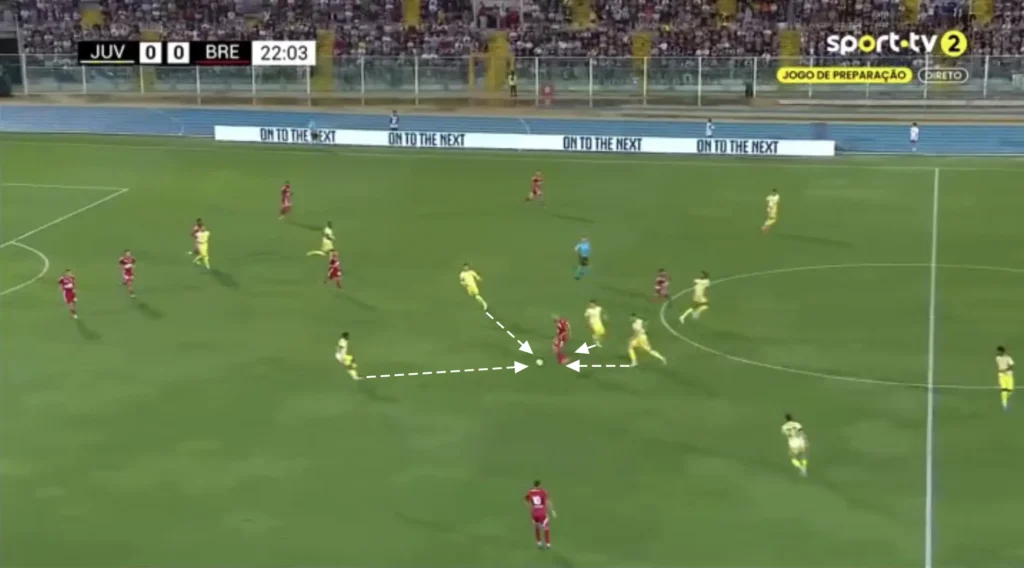
Counterpressing like this keeps Juventus on the front foot, allowing them to dominate possession and create more scoring opportunities. However, it requires exceptional fitness, tactical discipline, and teamwork, making it a hallmark of Thiago Motta’s dynamic and aggressive style of play.
Offensive Transitions
Thiago Motta also wants his team to counterattack in their offensive transitions. When winning the ball back, the team transitions quickly from defense to attack, utilizing the speed and movement of their forward players. Motta emphasizes vertical passes to exploit spaces left by the opposition, often targeting wide areas or gaps between defenders. Juventus’ counterattacks are well-organized, with players making intelligent off-the-ball runs to create overloads and support the ball carrier. This quick, direct style catches opponents off guard, making Juventus a dangerous team on the break. Additionally, Juventus’ aggressiveness means they have many players high up when defending, which enables them to incorporate more players into the counterattacks.
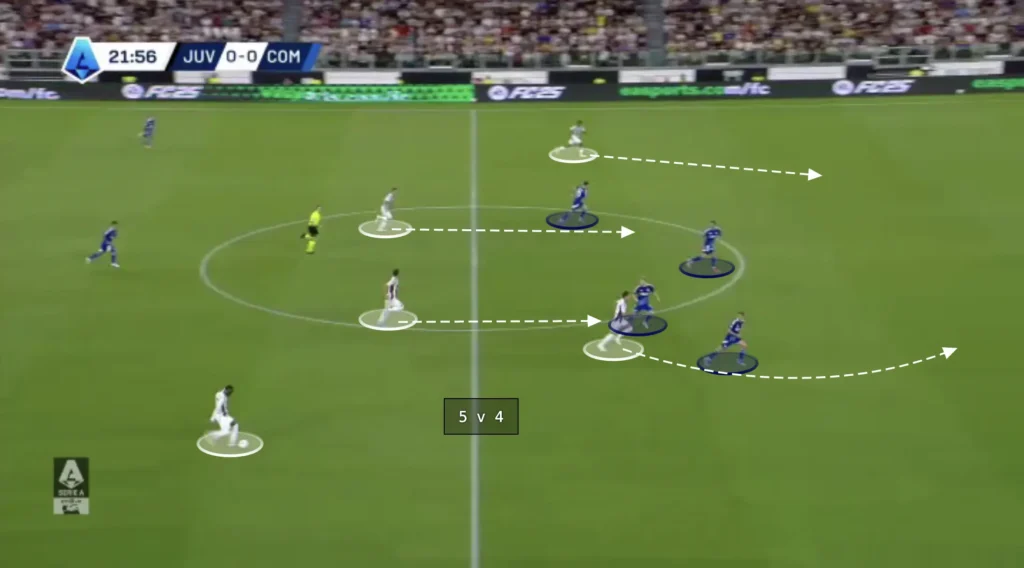
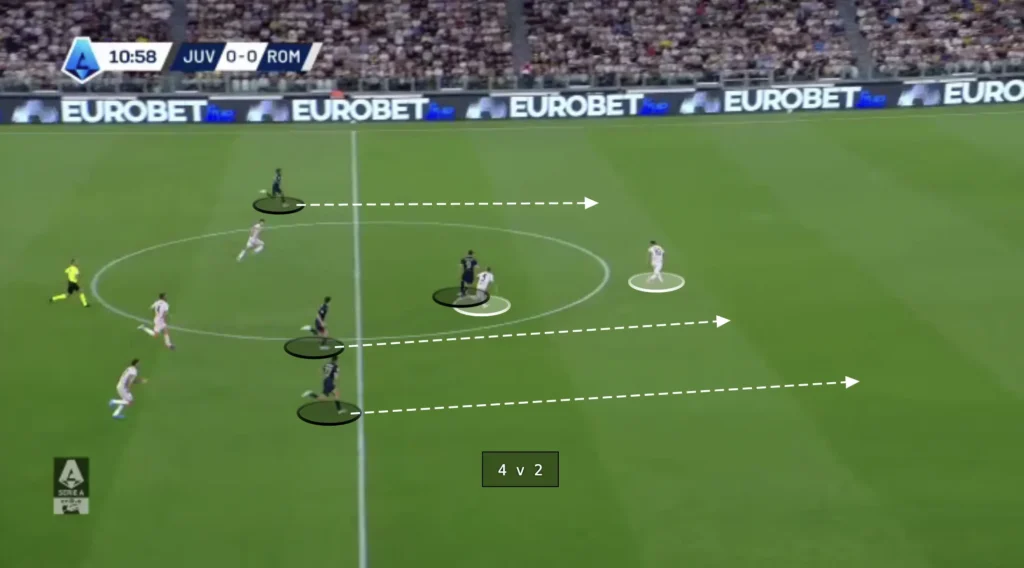
Final Thoughts
In conclusion, Thiago Motta’s tactical approach at Juventus highlights a well-structured and dynamic system that blends defensive discipline with fluid attacking play. His ability to organize the team, both in possession and in transition, showcases his deep understanding of the modern game. Motta’s Juventus emphasizes high pressing, intelligent movement, and a balanced approach that makes them difficult to break down while maintaining a potent attacking threat.
As Juventus continues to evolve under his leadership, Motta’s tactics will likely play a key role in shaping the team’s success. His influence is setting the foundation for a competitive and cohesive side that can challenge at the highest level.
